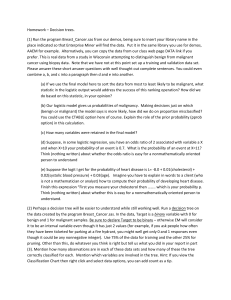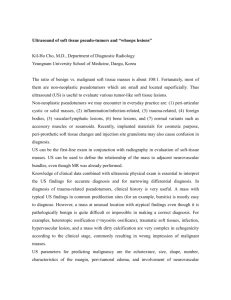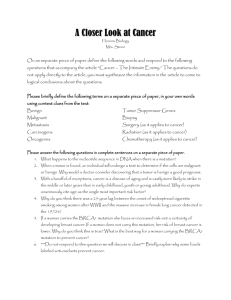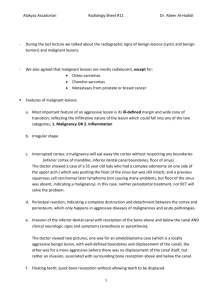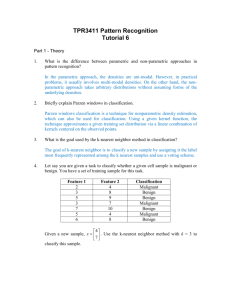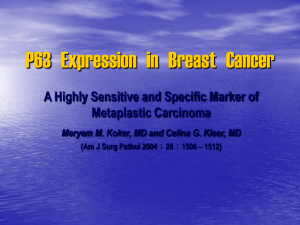Fibroepithelial and Spindle Cell Lesions of the Breast - IAP-AD
advertisement
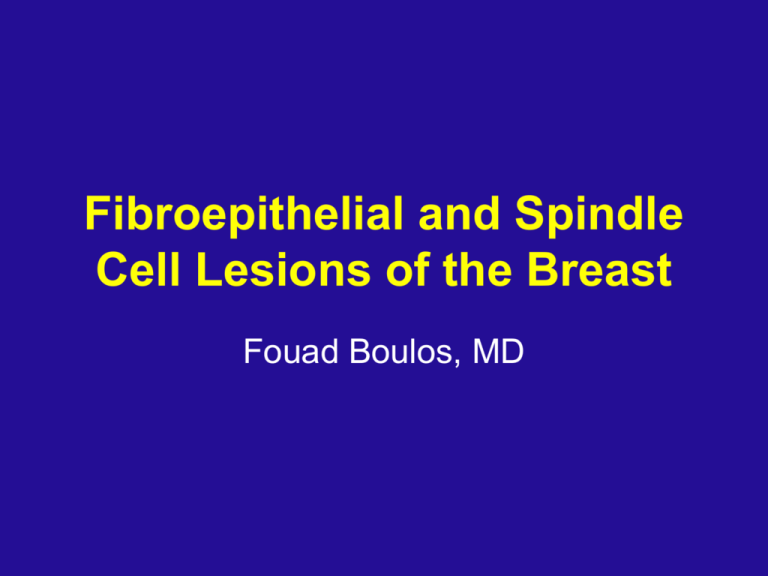
Fibroepithelial and Spindle Cell Lesions of the Breast Fouad Boulos, MD Fibroepithelial Lesions • Very common • Wide histologic spectrum • Vast majority benign Fibroadenoma • Hyperplasia of the lobular unit • Most common palpable lesion in young women • Peak incidence in third decade • May present as calcifications Fibroadenoma • Microscopically well-defined • Stroma with low cellularity • Intracanalicular and pericanalicular patterns FA and Epithelial Proliferations • Kuijper et al: 396 FAs – Hyperplasia 32% – DCIS 1.26% (5) – LCIS 0.76% (3) – 3 cases of CIS involved adjacent tissue – No invasive carcinoma FA with… • Carcinoma: re-excise especially if unclear about margins and FA shelled out • Atypical Hyperplasia: worry? Excise? FA with… • Carter et al: 1,834 women with FA 195068 – 0.81% had ADH or ALH – NO increased risk Special FAs • Juvenile FA – Large – Rapid growth (hormone sensitive) – Gynecomastoid hyperplasia – Increased stromal cellularity – Differential: Phyllodes vs virginal hypertrophy Special FAs • Complex FA – Apocrine change – Calcification – Cyst formation – Adenosis • Tubular adenoma • Lactational adenoma Fibroadenomatosis • Multiple • Ill-defined • Likely to “recur” Phyllodes Tumor • Biphasic with epithelial and stromal proliferation • Stroma more cellular than FA, and has propensity for malignant degeneration • Local recurrence common though majority benign Phyllodes Tumor • • • • 0.6% of all “malignant” breast tumors 40 and above 5 cm average size Well-circumscribed with leaf-like pattern Phyllodes Tumor • • • • Epithelial cells polyclonal Stromal cells clonal FA: both polyclonal Phyllodes can arise from FA Benign PT • Pushing margins • Minimal cellular atypia • Low mitotic rate (<4 per 10 hpf) Malignant PT • • • • Stromal overgrowth (4X without epithelium) Infiltrative border Stromal cellular atypia High mitotic rate (10 per 10 hpf) Borderline PT • As the name implies • Stromal cells cytologically similar to benign PT • Higher tendency for local recurrence because of infiltration and stromal overgrowth Malignant PT • Malignant heterologous elements are definitive clues to histologically malignant PT – Liposarcoma – Osteosarcoma – Fibrosarcoma Phyllodes Tumors • 45 cases from Memorial Sloan-Kettering aged 10-24 years – 34 benign – 11 malignant – 6/36 with f/u showed local recurrence – 1/36 metastasized (rhabdo) Phyllodes Tumors • 101 patients from MD Anderson – 58 benign, 12 borderline, and 30 malignant – 8 with distant mets – 13% 10-year rate – Stromal overgrowth is the only independent risk factor. Phyllodes Tumors Outcome Benign (Compiled from 7 studies) # 150 Rec 17% Mets 0 Death 0 Phyllodes Tumors Outcome Borderline (Compiled from 7 studies) # 36 Rec 33% Mets 6 Death 6 Phyllodes Tumors Outcome Malignant (Compiled from 7 studies) # 131 Rec 15% Mets 8 Death 8 SEER Data (1983-2002) • 821 malignant PT cases – 91% survival at 5 years – 89% survival at 15 years – Wide excision equivalent to mastectomy Few Pointers • • • • • Fibroadenoma with phyllodal features CD10 Epithelium can be very proliferative Metaplastic carcinoma within phyllodes Always look hard for the epithelial component (PT much more common than primary sarcomas in the breast) Summary • Wide excision very important • The more it looks like a soft tissue sarcoma, the more likely it is to behave like one • Rarely an aggressive tumor with fatal outcome Spindle Cell Lesions • All spindle cell lesions occurring in the soft tissues can happen in the breast • Overlapping morphologies for drastically different lesions • Important to maintain a wide differential Spindle Cell Lesions • Myofibroblastoma • Fibromatosis • Nodular fasciitis AND Their differentials… Myofibroblastoma • Originally thought to be a neoplasm of the male breast • Wide age range • Average size of 2.5 cm • Usually well-circumscribed Myofibroblastoma • Wide range of morphologies – Bland spindled to epithelioid cells with amphophilic cytoplasm in fascicles, singly, or in small clusters – Well-defined or infiltrating – Collagen or myxoid stroma – Pleomorphism (pleomorphic lipoma-like) Myofibroblastoma • Immunohistochemically – Desmin (large majority) – CD34 – SMA – Hormone Receptors Pitfalls of Myofibroblastoma • Infiltrative: Metaplastic carcinoma • Single epithelioid cells: Invasive lobular • Pleomorphic: Sarcoma Pitfalls of Myofibroblastoma • Infiltrative spindle: Metaplastic carcinoma – CK/p63/desmin/CD34 • Single epithelioid cells: Invasive lobular – CK/desmin • Pleomorphic: Soft tissue sarcoma – Overall features: no mitoses, small size, giant cells (floret) with smudged chromatin +/- IHC. Fibromatosis • As in non-mammary soft tissues, fibromatosis is a locally aggressive infiltrative benign mesenchymal neoplasm • Chest wall or primary, former more aggressive (desmoid type) • Frequently positive margins and local recurrence Fibromatosis • 30-60 years old • Palpable mass or suspicious mammographic lesion • Can cause skin changes if extends into dermis • Most sporadic but may occur as part of a genetic syndrome (APC/beta catenin) Fibromatosis • • • • • Average size 2.5 to 3 cm Entraps fat and epithelial structures Variably low cellularity Variably scant mitoses Bland tapering nuclei and little pink cytoplasm • Very long fascicles Fibromatosis • • • • Thick bands of collagen Centrifugal cellularity Thin-walled venules Lymphoid infiltrates perivascular and peripheral Fibromatosis • IHC: – Only helpful ruling out other entities – Nuclear beta catenin Differential of Fibromatosis • Scar – The re-excision problem • Nodular fasciitis • Metaplastic carcinoma (fibromatosis-like) Nodular Fasciitis • • • • • • Young adults Small (<5 cm) and subcutaneous Rapid preclinical phase Can be associated with pain Often spontaneously regresses Often a clinical mimicker of malignancy Nodular Fasciitis • Histology: – Well-defined not encapsulated – Space occupying though can be infiltrative – Can be quite cellular with mitoses – Plump stellate myofibroblasts in small whorls or fascicles and in loose matrix – Tissue culture appearance – No real atypia or necrosis Nodular Fasciitis • Histology: – Other features: • Thin walled vessels • Spattering of lymphoid cells (peripheral aggregates) • Red cell extravasation • Rarely osteocalst-like giant cells – Older lesions are variably cellular, myxoid or collagenized, with hypo/acellular center • IHC: Actin, rarely desmin Nodular Fasciitis • Differential diagnosis: – Malignant spindle cell lesions (metaplastic carcinoma, sarcoma) – Fibromatosis The main and most important differential is METAPLASTIC CARCINOMA A Few Words… • In our experience, a majority of spindle cell carcinomas are monophasic spindled • Low-grade fibromatosis-like to high grade pleomorphic • Often associated with DCIS or sclerosing lesions (low-grade) A Few Words… • Usually positive for 34ßE12 and p63 • Metaplastic carcinomas have a wide variety of appearances- low threshold for immunostaining: – Aggressive – Resistant to chemo – Hematogenous spread Take Home Messages • Exercise extreme caution when dealing with a core biopsy • Benign spindle cell lesions can look malignant and malignant ones can look benign • When in doubt, recommend excision without committing • IHC very helpful but can bring you down – Focal positivity missed – Non-specific staining (Giant cells) • Clinical and radiographic info should be sought
